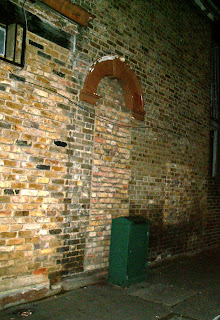‘Field
Study’s Man in E17’ has been in a funk recently and has been trying to walk
through and out of some of the darker atmospheres of his morbid state of mind. Here
are some images from a psycho ‘snappographic’ circumambulation undertaken by him one evening earlier this week. The walk took in a perusal of the
Hoe St Co-op skeps before a visit to the entrance of Queens Road Cemetery, and
then on to other sites of earthly or rather saturnine remains.
There is an
obvious funereal connection between Alstron House, the location of the
ornamental skeps, (‘Co-op funeral care’) and Queens Road Cemetery. That burial
ground is now full, according to the council web site. There seemed to him to
be a disparity between the coffins on display in the showroom and what he thinks
are the usual ethics and values of cooperatives/the cooperative movement. He
contemplated the various costs of the great inevitable while walking down Queen’s
Road, by streets most likely named after some of Queen Victoria’s children, (Leopold, Beatrice, Helena...) all
of whom are long dead.
'Field
Study’s Man in E17' is on the trail of a ghost story. In his forage for spooky
themes and ideas that night he found himself among chthonian bees, the
melissae, sent down from the moon goddess Artemis. By day, the bees are still,
suspended, stucco in, of and about her skeps. By night and the chill moonlight they, as disembodied souls, are released to transmigrate and forage along
the old ways, amongst the carved and moulded ornamental flora, of Walthamstow.
The stone
gate posts to the cemetery are eroded, the tree motifs substantially diminished
since their installation in 1872 (?). Could the motifs be ornamental renderings of yew trees and might that be a yew tree next to the entrance? If that is a ‘living’
yew at the entrance, might it have been a Victorian (or later) planting, an
indulgent harking back to ancient burial lore?
From Queens
Road, 'Field Study’s Man in E17' followed the drone of one of the sepulchral bees
down towards St James Park where, nearby, other sorts of remains were to be
found.
Further on and a browse of the Oxfam book window found the field student looking at a paper- back copy of
Charles Palliser, The Quincunx. What sort of coincidence was it that the
field student had just finished reading the first chapter of W G Sebald’s,
Rings of Saturn? In that chapter, Sebald cites Thomas Browne’s demonstrations
of, or allusions to, ‘the elegant geometrical designs of Nature’ (quincunx), as
well as his investigations into funeral rites leading to discourses such as, Hydriotaphia or Urn Burial 1658, in which he observes, ‘the
(pre-Christian) funeral pyres were built of sweet fuel, cypress, fir, yew, and
other trees perpetually verdant as silent expressions of their surviving
hopes’.
In Browne’s catalogue of the hopes once dispatched with the dead in urns, there is a collection of 300 golden bees.







No comments:
Post a Comment